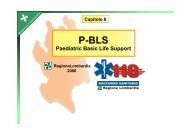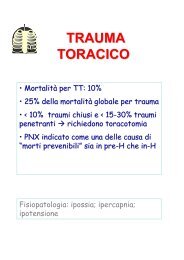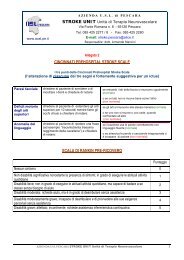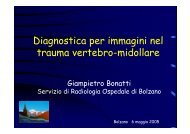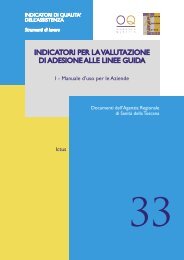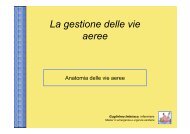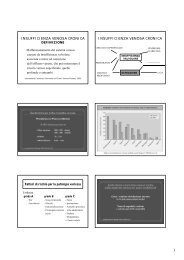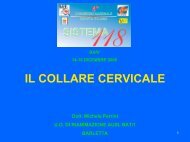“Riding the Waves” The Role of Capnography in EMS
“Riding the Waves” The Role of Capnography in EMS
“Riding the Waves” The Role of Capnography in EMS
You also want an ePaper? Increase the reach of your titles
YUMPU automatically turns print PDFs into web optimized ePapers that Google loves.
Rid<strong>in</strong>g <strong>the</strong> Waves…<strong>The</strong> <strong>Role</strong> <strong>of</strong> <strong>Capnography</strong> <strong>in</strong> <strong>EMS</strong><strong>“Rid<strong>in</strong>g</strong> <strong>the</strong> <strong>Waves”</strong><strong>The</strong> <strong>Role</strong> <strong>of</strong><strong>Capnography</strong> <strong>in</strong> <strong>EMS</strong>By Bob Page, AAS, NREMT-P, CCEMT-P, I/CTable <strong>of</strong> ContentsPage(s)Introduction and Objectives 2-3Module One: Review <strong>of</strong> Anatomy and PhysiologyAirway Review 4-7<strong>The</strong> Physiology <strong>of</strong> Respiration and Perfusion 8-14Module Two: <strong>The</strong> Technology <strong>of</strong> <strong>Capnography</strong>How EtCO 2 is measured 15Review <strong>of</strong> Technology 16Module Three: Cl<strong>in</strong>ical Applications <strong>of</strong> <strong>Capnography</strong>Waveform Interpretation 17-26ETT Conformation 27Closed Head Injuries 27Ventilatory assessment 27Perfusion trend<strong>in</strong>g 27Module Four: Practice Cases and Evaluations 28-34Clos<strong>in</strong>g Remarks 351
Rid<strong>in</strong>g <strong>the</strong> Waves…<strong>The</strong> <strong>Role</strong> <strong>of</strong> <strong>Capnography</strong> <strong>in</strong> <strong>EMS</strong>INTRODUCTION<strong>Capnography</strong> is a non<strong>in</strong>vasive method for monitor<strong>in</strong>g <strong>the</strong>level <strong>of</strong> carbon dioxide <strong>in</strong> exhaled breath (EtCO 2 ), toassess a patient’s ventilatory status. A true capnogramproduces an EtCO 2 value as well as a waveform, orcapnogram. On Critical Care transports, capnograms areuseful for monitor<strong>in</strong>g ventilator status, warn<strong>in</strong>g <strong>of</strong> airwayleaks and ventilator circuit disconnections. <strong>Capnography</strong>is also useful for ensur<strong>in</strong>g proper endotracheal tubeplacement. <strong>Capnography</strong> also helps cl<strong>in</strong>icians diagnosespecific medical conditions, make treatment decisions,and assess efficacy <strong>of</strong> code efforts and predict outcome.<strong>Capnography</strong> <strong>of</strong>fers numerous cl<strong>in</strong>ical uses, but technicallimitations have prevented <strong>EMS</strong> personnel fromembrac<strong>in</strong>g its use outside <strong>the</strong> operat<strong>in</strong>g room. Today,technological advances have made it possible for <strong>the</strong>sedevices to be used <strong>in</strong> <strong>the</strong> demand<strong>in</strong>g sett<strong>in</strong>g <strong>of</strong> <strong>the</strong>prehospital environment.2
Rid<strong>in</strong>g <strong>the</strong> Waves…<strong>The</strong> <strong>Role</strong> <strong>of</strong> <strong>Capnography</strong> <strong>in</strong> <strong>EMS</strong>OBJECTIVES for <strong>the</strong> Session:By <strong>the</strong> end <strong>of</strong> this session, you will be able to:‣ Describe <strong>the</strong> structure and function <strong>of</strong> <strong>the</strong> upper and lowerairways.‣ Describe <strong>the</strong> mechanics and science <strong>of</strong> ventilation andrespiration.‣ Describe <strong>the</strong> basic physiology <strong>of</strong> perfusion.‣ Describe <strong>the</strong> relationship between ventilation and perfusion.‣ Describe <strong>the</strong> pr<strong>in</strong>ciples beh<strong>in</strong>d CO 2 measurement.‣ Describe <strong>the</strong> various methods <strong>of</strong> EtCO 2 measurement<strong>in</strong>clud<strong>in</strong>g quantitative and qualitative capnometry andcapnography.‣ Describe <strong>the</strong> technology <strong>of</strong> EtCO 2 measurement <strong>in</strong>clud<strong>in</strong>gma<strong>in</strong>stream, sidestream and microstream sampl<strong>in</strong>g.‣ Identify <strong>the</strong> components <strong>of</strong> a normal capnogram waveform.‣ Identify abnormal capnogram waveforms as related tovarious airway, breath<strong>in</strong>g and circulation problems.‣ Discuss <strong>the</strong> various cl<strong>in</strong>ical applications <strong>of</strong> capnography <strong>in</strong><strong>the</strong> field.‣ Given various cases, discuss <strong>the</strong> role <strong>of</strong> capnography <strong>in</strong>identify<strong>in</strong>g <strong>the</strong> problem and <strong>in</strong> <strong>the</strong> management <strong>of</strong> <strong>the</strong>patient.3
Rid<strong>in</strong>g <strong>the</strong> Waves…<strong>The</strong> <strong>Role</strong> <strong>of</strong> <strong>Capnography</strong> <strong>in</strong> <strong>EMS</strong>MODULE ONE:REVIEW OF AIRWAY ANATOMY AND PHYSIOLOGYN as al P as s ag e sR o o f o f th e M o u thE p ig lo ttisTra c he a (w <strong>in</strong> d p ip e )E s o p h ag u s (fo o d tu b e )P u lm o n a ry V e <strong>in</strong>B ro n c h io l eB ro n c h iA lv e o l iTwo divisions to <strong>the</strong> airway:1. Upper Airway2. Lower Airway4
Rid<strong>in</strong>g <strong>the</strong> Waves…<strong>The</strong> <strong>Role</strong> <strong>of</strong> <strong>Capnography</strong> <strong>in</strong> <strong>EMS</strong>Airway Anatomy Review‣ Upper AirwayNasopharynxOropharnyxPalatesHard and s<strong>of</strong>tLarynxEpiglottisVocal cordsUpper Airway Physiology: PEEP or Positive End ExpiratoryPressure can be def<strong>in</strong>ed as <strong>the</strong> pressure aga<strong>in</strong>st which exhalationoccurs. <strong>The</strong> purpose <strong>of</strong> PEEP is to prevent alveolar collapse. <strong>The</strong>structure and path way <strong>of</strong> <strong>the</strong> upper airways provide for a naturalor “physiological PEEP.”<strong>The</strong> primary roles <strong>of</strong> <strong>the</strong> upper airway are to ____________,______________, and _______________ <strong>the</strong> air enter<strong>in</strong>g<strong>the</strong> lungs.5
Rid<strong>in</strong>g <strong>the</strong> Waves…<strong>The</strong> <strong>Role</strong> <strong>of</strong> <strong>Capnography</strong> <strong>in</strong> <strong>EMS</strong>‣ Lower AirwayTracheaBronchiBronchiolesDead Space Air<strong>The</strong> lower airway is comprised <strong>of</strong> <strong>the</strong> trachea, bronchi and <strong>the</strong>n25 divisions <strong>of</strong> <strong>the</strong> bronchial tree term<strong>in</strong>at<strong>in</strong>g at <strong>the</strong>respiratory bronchioles and <strong>the</strong> alveoli.<strong>The</strong> areas from <strong>the</strong> bronchioles to <strong>the</strong> nose comprise <strong>the</strong> totaldead space air. This is air that is not exchanged.6
Rid<strong>in</strong>g <strong>the</strong> Waves…<strong>The</strong> <strong>Role</strong> <strong>of</strong> <strong>Capnography</strong> <strong>in</strong> <strong>EMS</strong>BronchiolesAlveoli<strong>The</strong> alveoli are t<strong>in</strong>y air sacs where gas exchange occurs. O 2 andCO 2 are exchanges at <strong>the</strong> capillary-alveolar membrane.7
Rid<strong>in</strong>g <strong>the</strong> Waves…<strong>The</strong> <strong>Role</strong> <strong>of</strong> <strong>Capnography</strong> <strong>in</strong> <strong>EMS</strong>THE PHYSIOLOGY OF VENTILATIONRule # 1 <strong>of</strong> LifeAir must go<strong>in</strong> and out‣ Function <strong>of</strong> ventilation:Ventilation is <strong>the</strong> movement <strong>of</strong> air.• Designed to elim<strong>in</strong>ate CO 2 and take <strong>in</strong> O 2How air moves (and it MUST move)‣ Chemoreceptors <strong>in</strong> <strong>the</strong> medulla sense elevated levels <strong>of</strong> CO 2or lowered pH, trigger<strong>in</strong>g ventilation. Known as hypercarbicdrive.‣ Diaphragm contracts and moves downward.‣ Intercostal muscles spread chest wall out <strong>in</strong>creas<strong>in</strong>g <strong>the</strong>volume <strong>in</strong>side <strong>the</strong> chest.‣ Differences <strong>in</strong> pressure <strong>in</strong>side <strong>the</strong> chest and outside causesair to move <strong>in</strong>to <strong>the</strong> lungs.‣ Hypoxic drive (low O 2 levels) is secondary drive.8
Rid<strong>in</strong>g <strong>the</strong> Waves…<strong>The</strong> <strong>Role</strong> <strong>of</strong> <strong>Capnography</strong> <strong>in</strong> <strong>EMS</strong>VOLUME CAPACITIES‣ Tidal Volume (Vt): <strong>The</strong> amount <strong>of</strong> air moved <strong>in</strong> one breath• Typically 500 cc <strong>in</strong> an adult at rest‣ Anatomical Dead Space (Vd): Air not available for gasexchange• About 150 cc‣ Alveolar volume (Va); Air that is available for gas exchange• About 350 cc (Vt – Vd = Va)• Anyth<strong>in</strong>g that affects <strong>the</strong> tidal volume only affects <strong>the</strong>alveolar volume.Factors affect<strong>in</strong>g <strong>the</strong> tidal volume‣ Hyperventilation• Fast breath<strong>in</strong>g (tachypnea) doesn’t necessarily <strong>in</strong>creasetidal volume• Anxiety, head <strong>in</strong>juries, diabetic emergencies, PE, AMI,and o<strong>the</strong>rs‣ Hypoventilation• Slow breath<strong>in</strong>g (bradypnea) does not necessarilydecrease tidal volume.• Causes <strong>in</strong>clude CNS disorders, narcotic use and o<strong>the</strong>rs.Street Wisdom: An <strong>in</strong>crease or decrease <strong>in</strong> tidal volume is at<strong>the</strong> expense or benefit <strong>of</strong> alveolar air.9
Rid<strong>in</strong>g <strong>the</strong> Waves…<strong>The</strong> <strong>Role</strong> <strong>of</strong> <strong>Capnography</strong> <strong>in</strong> <strong>EMS</strong>Respiration is <strong>the</strong> exchange <strong>of</strong> gasesAlveolar respiration occurs between <strong>the</strong> _______ and_________ <strong>in</strong> <strong>the</strong> lungs.10
Rid<strong>in</strong>g <strong>the</strong> Waves…<strong>The</strong> <strong>Role</strong> <strong>of</strong> <strong>Capnography</strong> <strong>in</strong> <strong>EMS</strong>Cellular respiration occurs between <strong>the</strong> _____ <strong>in</strong> <strong>the</strong> bodyand <strong>the</strong> _____________.When <strong>the</strong>re is a difference <strong>in</strong> partial pressure between <strong>the</strong>two conta<strong>in</strong>ers, gas will move from <strong>the</strong> area <strong>of</strong> greaterconcentrations to <strong>the</strong> area <strong>of</strong> lower concentration. a.k.a.diffusion11
Rid<strong>in</strong>g <strong>the</strong> Waves…<strong>The</strong> <strong>Role</strong> <strong>of</strong> <strong>Capnography</strong> <strong>in</strong> <strong>EMS</strong>THE PHYSIOLOGY OF PERFUSIONRule # 2 <strong>of</strong> LifeBlood must goround and round.‣ Fick pr<strong>in</strong>ciple: Oxygen Transport‣ In order from adequate cellular perfusion to occur, <strong>the</strong>follow<strong>in</strong>g must be present:• Adequate number <strong>of</strong> Red Blood Cells (RBC’s)♦ Hemoglob<strong>in</strong> on <strong>the</strong> RBC’s carry <strong>the</strong> oxygen molecules• Adequate O 2♦ Patient must have adequate O 2 com<strong>in</strong>g <strong>in</strong>. See Rule<strong>of</strong> Life #1• RBC’s must be able to <strong>of</strong>fload and take on O 2♦ Some conditions such as carbon monoxide poison<strong>in</strong>gand cyanide poison<strong>in</strong>g affect <strong>the</strong> RBC’s ability tob<strong>in</strong>d and release O 2 molecules.• Adequate blood pressure to push cells12
Rid<strong>in</strong>g <strong>the</strong> Waves…<strong>The</strong> <strong>Role</strong> <strong>of</strong> <strong>Capnography</strong> <strong>in</strong> <strong>EMS</strong>PHYSIOLOGIC BALANCEMore Air Less BloodV > QEqual Air and BloodV = QMore Blood Less AirV < Q‣ Pathological Conditions• Normal ventilation, poor perfusion: P.E., Arrest• Abnormal ventilation, good perfusion: obstruction, O.P.D.,drug OD• Bad ventilation and perfusion: Arrest• Bad exchange area: CHF13
Rid<strong>in</strong>g <strong>the</strong> Waves…<strong>The</strong> <strong>Role</strong> <strong>of</strong> <strong>Capnography</strong> <strong>in</strong> <strong>EMS</strong>Critical Th<strong>in</strong>k<strong>in</strong>g Cases – Designed to illustrate <strong>the</strong>pathophysiology‣ Normal ventilation/normal perfusion‣ Normal ventilation/compromised perfusion‣ Compromised ventilation/normal perfusion‣ Compromised ventilation and perfusion1. 26 year-old female patient took an overdose <strong>of</strong> Valium. She isUNCONSCIOUS. V/S are 110/70, pulse is 64, RR is 12 and veryshallow, sk<strong>in</strong> is warm and dry.2. 65 year-old male patient compla<strong>in</strong><strong>in</strong>g <strong>of</strong> a sudden onset <strong>of</strong> rightsided chest pa<strong>in</strong> and dyspnea. He has no medical history except fora hip replacement surgery about 3 weeks ago. His lung sounds areclear. VS are B/P 140/78, pulse is 110, and RR is about 20 andnormal depth.3. 80 year-old man compla<strong>in</strong>s <strong>of</strong> a sudden onset <strong>of</strong> severe headache.He has flushed sk<strong>in</strong>, and has obvious facial droop to <strong>the</strong> left side.He has a history <strong>of</strong> high blood pressure. V/S are B/P 180/110,pulse is 100 and RR is 16 and normal depth.4. 37 year-old female that was <strong>in</strong>volved <strong>in</strong> a head on collision.W<strong>in</strong>dshield is starred and <strong>the</strong> steer<strong>in</strong>g wheel is broke. Bruis<strong>in</strong>g andcrepitus found over <strong>the</strong> left chest. Pt is unconscious, difficult tobag with absent lungs sounds on <strong>the</strong> left side. Blood pressure is60/40; pulse is 130 and weak at <strong>the</strong> carotid. <strong>The</strong>re is obvious JVD.Sk<strong>in</strong> is cool and clammy.14
Rid<strong>in</strong>g <strong>the</strong> Waves…<strong>The</strong> <strong>Role</strong> <strong>of</strong> <strong>Capnography</strong> <strong>in</strong> <strong>EMS</strong>MODULE TWO:TECHNOLOGY OF CAPNOGRAPHY<strong>The</strong> <strong>Role</strong> <strong>of</strong> CO 2‣ CO 2 is <strong>the</strong> “Gas <strong>of</strong> Life”‣ Produced as a normal by-product <strong>of</strong> metabolism.Measurement <strong>of</strong> EtCO 2 (Capnometry)‣ Qualitative• Color change assay• (CO 2 turns <strong>the</strong> sensor from purple to yellow)‣ Quantitative• Gives you a value (EtCO 2 )• Respiratory RateWaveform <strong>Capnography</strong>‣ Features quantitative value and waveform‣ <strong>Capnography</strong> <strong>in</strong>cludes CapnometryStreet Wisdom: “End Tidal CO 2 read<strong>in</strong>g without a waveform islike a heart rate without an ECG record<strong>in</strong>g.”15
Rid<strong>in</strong>g <strong>the</strong> Waves…<strong>The</strong> <strong>Role</strong> <strong>of</strong> <strong>Capnography</strong> <strong>in</strong> <strong>EMS</strong>‣ Infrared (IR) Spectroscopy:• Most <strong>of</strong>ten used• Infrared light is used to expose <strong>the</strong> sample• IR sensors detect <strong>the</strong> absorbed light and calculate avalue• Broad spectrum IR beams can be absorbed N 2 0 and HighO 2 levels‣ Side stream sampl<strong>in</strong>g• “First generation devices”• Draws large sample <strong>in</strong>to mach<strong>in</strong>e from <strong>the</strong> l<strong>in</strong>e• Can be used on <strong>in</strong>tubated and non-<strong>in</strong>tubated patients witha nasal cannula attachment• “Second generation devices”• Airway mounted sensors• Generally for <strong>in</strong>tubated patients‣ Microstream Technology• Position <strong>in</strong>dependent adaptors• Moisture, secretion, and contam<strong>in</strong>ant handl<strong>in</strong>g <strong>in</strong> threeways• Samples taken from center <strong>of</strong> l<strong>in</strong>e, and <strong>in</strong> 1/20 th <strong>the</strong>volume• Vapor permeable tub<strong>in</strong>g• Sub micron-multi-surface filters• Expensive parts are protected• Microbeam IR sensor is CO 2 specific• Suitable for adult and pediatric environments.16
Rid<strong>in</strong>g <strong>the</strong> Waves…<strong>The</strong> <strong>Role</strong> <strong>of</strong> <strong>Capnography</strong> <strong>in</strong> <strong>EMS</strong>Systematic Approach to Waveform Interpretation1. Is CO 2 present? (waveform present)2. Look at <strong>the</strong> respiratory basel<strong>in</strong>e. Is <strong>the</strong>re rebreath<strong>in</strong>g?3. Expiratory Upstroke: Steep, slop<strong>in</strong>g, or prolonged?4. Expiratory (alveolar) Plateau: Flat, prolonged, notched, orslop<strong>in</strong>g?5. Inspiratory Downstroke: Sleep, slop<strong>in</strong>g, or prolonged?6. Read <strong>the</strong> EtCO 27. If ABG is available, compare <strong>the</strong> EtCO 2 with PACO 2a. If <strong>the</strong>y are with<strong>in</strong> 5mm/hg <strong>of</strong> each o<strong>the</strong>r <strong>the</strong>n <strong>the</strong>problem is ventilatory and not perfusion.b. EtCO 2 can be used <strong>in</strong> many cases <strong>in</strong> lieu <strong>of</strong> ABG’s<strong>The</strong> ABC’s <strong>of</strong> Waveform Interpretation!A – Airway: Look for signs <strong>of</strong> obstructed airway (steep,upslop<strong>in</strong>g expiratory plateau)B – Breath<strong>in</strong>g: Look at EtCO 2 read<strong>in</strong>g. Look for waveforms,and elevated respiratory basel<strong>in</strong>e.C – Circulation: Look at trends, long and short term for<strong>in</strong>creases or decreases <strong>in</strong> EtCO 2 read<strong>in</strong>gs18
Rid<strong>in</strong>g <strong>the</strong> Waves…<strong>The</strong> <strong>Role</strong> <strong>of</strong> <strong>Capnography</strong> <strong>in</strong> <strong>EMS</strong>Street wisdom: A patient compla<strong>in</strong>s <strong>of</strong> hav<strong>in</strong>g difficultybreath<strong>in</strong>g. <strong>The</strong> pulse oximeter shows 98% on 15 lpm O 2 . Asyou attempt to listen to lung sounds, <strong>the</strong>y are hard to makeout <strong>in</strong> <strong>the</strong> back <strong>of</strong> <strong>the</strong> ambulance. What benefit, if any couldcapnography make <strong>in</strong> <strong>the</strong> diagnosis and management <strong>of</strong> thispatient?What is <strong>the</strong> difference between pulse oximetry andcapnography?SpO 2 = Pulse oximetry – measures oxygenationEtCO 2 = <strong>Capnography</strong> – measures ventilation19
Rid<strong>in</strong>g <strong>the</strong> Waves…<strong>The</strong> <strong>Role</strong> <strong>of</strong> <strong>Capnography</strong> <strong>in</strong> <strong>EMS</strong>NORMAL CAPNOGRAPHY5 04 03 02 01 00T i m eThis is a normal capnogram that has all <strong>of</strong> <strong>the</strong> phases that areeasily appreciated. Note <strong>the</strong> gradual upslope and alveolar“Plateau”Po<strong>in</strong>t for thought:List <strong>the</strong> th<strong>in</strong>gs a normal capnogram tells you and <strong>the</strong> th<strong>in</strong>gs that itdoes not tell you.20
Rid<strong>in</strong>g <strong>the</strong> Waves…<strong>The</strong> <strong>Role</strong> <strong>of</strong> <strong>Capnography</strong> <strong>in</strong> <strong>EMS</strong>ABNORMAL CAPNOGRAPHY‣ HyperventilationThis capnogram starts slow and has an EtCO 2 read<strong>in</strong>g that isnormal. Notice as <strong>the</strong> rate gets faster, <strong>the</strong> waveform getsnarrower and <strong>the</strong>re is a steady decrease <strong>in</strong> <strong>the</strong> EtCO 2 to below30mm/hg. Causes <strong>of</strong> this type <strong>of</strong> waveform <strong>in</strong>clude:504030201006050403020100TimeEtCO2 mmHgTime‣ Hyperventilation syndrome‣ Overzealous bagg<strong>in</strong>g‣ Pulmonary embolism21
Rid<strong>in</strong>g <strong>the</strong> Waves…<strong>The</strong> <strong>Role</strong> <strong>of</strong> <strong>Capnography</strong> <strong>in</strong> <strong>EMS</strong>‣ Hypoventilation5 04 03 02 01 00T i m eIn this capnogram, <strong>the</strong>re is a gradual <strong>in</strong>crease <strong>in</strong> <strong>the</strong> EtCO 2 .Obstruction is not apparent. Causes <strong>of</strong> this may <strong>in</strong>clude:Respiratory depression for any reason‣ Narcotic overdose‣ CNS dysfunction‣ Heavy sedation22
Rid<strong>in</strong>g <strong>the</strong> Waves…<strong>The</strong> <strong>Role</strong> <strong>of</strong> <strong>Capnography</strong> <strong>in</strong> <strong>EMS</strong>‣ Apnea6050403020100EtCOTime2 mmHgThis capnogram shows a complete loss <strong>of</strong> waveform <strong>in</strong>dicat<strong>in</strong>gno CO 2 present. <strong>Capnography</strong> allows for <strong>in</strong>stantaneousrecognition <strong>of</strong> this potentially fatal condition. S<strong>in</strong>ce thisoccurred suddenly, consider <strong>the</strong> follow<strong>in</strong>g causes:‣ Dislodged ET Tube‣ Total obstruction <strong>of</strong> ET Tube‣ Respiratory arrest <strong>in</strong> <strong>the</strong> non-<strong>in</strong>tubated patient‣ Equipment malfunction (If <strong>the</strong> patient is still breath<strong>in</strong>g) Checkall connections and sampl<strong>in</strong>g chambers23
Rid<strong>in</strong>g <strong>the</strong> Waves…<strong>The</strong> <strong>Role</strong> <strong>of</strong> <strong>Capnography</strong> <strong>in</strong> <strong>EMS</strong>Loss <strong>of</strong> Alveolar Plateau50403020100TimeThis capnogram displays an abnormal loss <strong>of</strong> alveolar plateaumean<strong>in</strong>g <strong>in</strong>complete or obstructed exhalation. Note <strong>the</strong>“Shark’s f<strong>in</strong>” pattern. This pattern is found <strong>in</strong> <strong>the</strong> follow<strong>in</strong>gBronchoconstriction‣ Asthma‣ COPD‣ Incomplete airway obstruction‣ Upper airway• Tube k<strong>in</strong>ked or obstructed by mucous24
Rid<strong>in</strong>g <strong>the</strong> Waves…<strong>The</strong> <strong>Role</strong> <strong>of</strong> <strong>Capnography</strong> <strong>in</strong> <strong>EMS</strong>‣ Poor perfusion (cardiac arrest)6050403020100<strong>The</strong> capnogram can <strong>in</strong>dicate perfusion dur<strong>in</strong>g CPR andeffectiveness <strong>of</strong> resuscitation efforts. Note <strong>the</strong> trough <strong>in</strong> <strong>the</strong>center <strong>of</strong> <strong>the</strong> capnogram. Dur<strong>in</strong>g this time, <strong>the</strong>re was a change<strong>in</strong> personnel do<strong>in</strong>g CPR. <strong>The</strong> fatigue <strong>of</strong> <strong>the</strong> first rescuer wasdemonstrated when <strong>the</strong> second rescuer took overcompressions.EtCO2 mmHgTime: 30 m<strong>in</strong>ute trend6050403020100EtCO 2 mmHgTime: trend 30 m<strong>in</strong>utesThis patient was defibrillated successfully with a return <strong>of</strong>spontaneous pulse.Notice <strong>the</strong> dramatic change <strong>in</strong> <strong>the</strong> EtCO 2 when pulses wererestored.Studies have shown that consistently low read<strong>in</strong>gs (less than10mm) dur<strong>in</strong>g resuscitation reflect a poor outcome and futileresuscitation.25
Rid<strong>in</strong>g <strong>the</strong> Waves…<strong>The</strong> <strong>Role</strong> <strong>of</strong> <strong>Capnography</strong> <strong>in</strong> <strong>EMS</strong>‣ Elevated Basel<strong>in</strong>e6050403020100EtCO Time 2 mmHgThis capnogram demonstrates an elevation to <strong>the</strong> basel<strong>in</strong>e.This <strong>in</strong>dicates <strong>in</strong>complete <strong>in</strong>halation and or exhalation. CO 2does not get completely washed out on <strong>in</strong>halation. Possiblecauses for this <strong>in</strong>clude:‣ Air trapp<strong>in</strong>g (as <strong>in</strong> asthma or COPD)‣ CO 2 rebreath<strong>in</strong>g (ventilator circuit problem)What o<strong>the</strong>r condition(s) might produce this type <strong>of</strong>waveform?26
Rid<strong>in</strong>g <strong>the</strong> Waves…<strong>The</strong> <strong>Role</strong> <strong>of</strong> <strong>Capnography</strong> <strong>in</strong> <strong>EMS</strong>Field Cl<strong>in</strong>ical Applications for <strong>Capnography</strong>‣ Closed Head Injury‣ Increased <strong>in</strong>tracranial pressure (ICP) tied to <strong>in</strong>creasedblood flow follow<strong>in</strong>g <strong>in</strong>jury (swell<strong>in</strong>g)‣ Hypoxic cells produce CO 2 <strong>in</strong> <strong>the</strong> bra<strong>in</strong>‣ CO 2 causes vasodilation and more blood fills <strong>the</strong> cranium,<strong>in</strong>creas<strong>in</strong>g pressure.‣ Hyperventilation is no longer recommended‣ Ventilation should be geared towards controll<strong>in</strong>g CO 2 levelsbut not overdo<strong>in</strong>g it.‣ Obstructive Pulmonary Diseases• Asthma, COPD• Waveform can <strong>in</strong>dicate bronchoconstriction wherewheezes might not have been heard• Monitor <strong>the</strong> effectiveness <strong>of</strong> bronchodilator <strong>the</strong>rapy‣ Tube Conformation• <strong>Capnography</strong> will detect <strong>the</strong> presence <strong>of</strong> CO 2 <strong>in</strong> expiredair conform<strong>in</strong>g ETT placement• No longer acceptable to use only lungs sounds to confirm• A dislodged tube will be detected immediately withcapnography• K<strong>in</strong>k<strong>in</strong>g or clott<strong>in</strong>g tubes can also be detected• In cases <strong>of</strong> ventilator use, capnography can detectproblems <strong>in</strong> rebreath<strong>in</strong>g.‣ Perfusion• <strong>Capnography</strong> can be set up to trend EtCO 2 to detect <strong>the</strong>presence or absence <strong>of</strong> perfusion• Is a proven predictor <strong>of</strong> those who do not surviveresuscitation• When an ABG is available, can detect ventilatory orperfusion problems27
Rid<strong>in</strong>g <strong>the</strong> Waves…<strong>The</strong> <strong>Role</strong> <strong>of</strong> <strong>Capnography</strong> <strong>in</strong> <strong>EMS</strong>MODULE FOUR:CASE SIMULATIONS AND EVALUATIONCASE # 1PresentationPatient is a 65 year old male compla<strong>in</strong><strong>in</strong>g <strong>of</strong> crush<strong>in</strong>g substernalchest pa<strong>in</strong>. He rates <strong>the</strong> pa<strong>in</strong> as a 10 on a scale <strong>of</strong> one to ten. Hedenies and shortness <strong>of</strong> breath or any o<strong>the</strong>r compla<strong>in</strong>ts. He has ahistory <strong>of</strong> cardiac disease and asthma.Cl<strong>in</strong>ical SituationV/S: 130/80, Pulse is 100, RR is about 20SpO 2 is 96%, EtCO 2 is 40Cardiac Monitor shows S<strong>in</strong>us TachycardiaHis capnogram is as follows.6050403020100EtCOTime 2 mmHgQuestions:Is <strong>the</strong> EtCO 2 with<strong>in</strong> normal limits?Is <strong>the</strong> waveform normal or abnormal? Why or Why Not?What can you deduce about <strong>the</strong> ventilation status?ABC28
Rid<strong>in</strong>g <strong>the</strong> Waves…<strong>The</strong> <strong>Role</strong> <strong>of</strong> <strong>Capnography</strong> <strong>in</strong> <strong>EMS</strong>CASE #2PresentationPatient is a 25-year-old male patient with a history <strong>of</strong> asthma. Hehas been compliant with his medications until he ran out <strong>of</strong>albuterol. Today, while at a basketball game, he suddenly getsshort <strong>of</strong> breath. He does not have his albuterol <strong>in</strong>haler with him.He presents sitt<strong>in</strong>g <strong>in</strong> <strong>the</strong> bleachers, <strong>in</strong> m<strong>in</strong>or respiratorydistress. It is noisy and hard to hear lung sounds.Cl<strong>in</strong>ical SituationB/P 120/76Pulse 100RR – 14SpO 2 94EtCO 2 is 506050403020100Questions:EtCOTime2 mmHgIs <strong>the</strong> EtCO 2 with<strong>in</strong> normal limits?Is <strong>the</strong> waveform normal or abnormal? Why or Why Not?What can you deduce about <strong>the</strong> ventilation status?ABC29
Rid<strong>in</strong>g <strong>the</strong> Waves…<strong>The</strong> <strong>Role</strong> <strong>of</strong> <strong>Capnography</strong> <strong>in</strong> <strong>EMS</strong>CASE #3PresentationYou and your partner are work<strong>in</strong>g a cardiac arrest and aresuccessful <strong>in</strong> resuscitation. <strong>The</strong> Patient is still unstable and <strong>the</strong>decision is made to load and go because <strong>of</strong> <strong>the</strong> very shorttransport time to <strong>the</strong> ED. He is <strong>in</strong>tubated and EtCO 2 confirmedwith good waveform and an EtCO 2 <strong>of</strong> about 42mm/hg.<strong>The</strong> patient is not breath<strong>in</strong>g on <strong>the</strong>ir own.Cl<strong>in</strong>ical Situation:6050403020100EtCO Time 2 mmHgB/P is 100/70Pulse is 88RR assistedSpO 2 is 100% on 15lpm via NRB maskEtCO 2 is 40-42After load<strong>in</strong>g him <strong>in</strong>to <strong>the</strong> ambulance, <strong>the</strong> first respondersresume ventilation. <strong>The</strong> capnography alarm sounds and <strong>the</strong>follow<strong>in</strong>g waveform is seen:6050403020100EtCOTime2 mmHg30
Rid<strong>in</strong>g <strong>the</strong> Waves…<strong>The</strong> <strong>Role</strong> <strong>of</strong> <strong>Capnography</strong> <strong>in</strong> <strong>EMS</strong>CASE # 3 Cont<strong>in</strong>uedQuestions:Is <strong>the</strong> EtCO 2 with<strong>in</strong> normal limits?Is <strong>the</strong> waveform normal or abnormal? Why or Why Not?What can you deduce about <strong>the</strong> ventilation status?ABC31
Rid<strong>in</strong>g <strong>the</strong> Waves…<strong>The</strong> <strong>Role</strong> <strong>of</strong> <strong>Capnography</strong> <strong>in</strong> <strong>EMS</strong>CASE # 4PresentationYou have a 30-year-old female who was <strong>in</strong> status seizures. Yourpartner adm<strong>in</strong>isters Valium to halt <strong>the</strong> seizures. <strong>The</strong> patientappears to be post-ictal but is slow to respond fully.Cl<strong>in</strong>ical SituationB/P is 114/68Pulse is 96RR is 12SpO 2 is 98 on 6 lpm nasal cannulaGlucose is 100EtCO 2 is as follows6050403020100Questions:EtCO Time 2 mmHgIs <strong>the</strong> EtCO 2 with<strong>in</strong> normal limits?Is <strong>the</strong> waveform normal or abnormal? Why or Why Not?What can you deduce about <strong>the</strong> ventilation status?ABC32
Rid<strong>in</strong>g <strong>the</strong> Waves…<strong>The</strong> <strong>Role</strong> <strong>of</strong> <strong>Capnography</strong> <strong>in</strong> <strong>EMS</strong>CASE # 5PresentationIt’s 3 am and you are called to a residence for a 60 year old manthat is <strong>in</strong> respiratory distress. You f<strong>in</strong>d <strong>the</strong> gentleman sitt<strong>in</strong>g upon his bed with feet dangl<strong>in</strong>g <strong>of</strong>f <strong>the</strong> end. He presents <strong>in</strong> obviousdistress and cannot speak words due to <strong>the</strong> distress. His lungfields are very dim<strong>in</strong>ished with crackles heard. He is pale anddiaphoretic and appears to be gett<strong>in</strong>g weaker. Family memberstell you that he has a bad heart and takes a “heart pill”, and a“water pill”. Pt becomes obtunded with labored breath<strong>in</strong>g. <strong>The</strong>ystill have a gag reflex.Cl<strong>in</strong>ical PresentationBP is 158/90HR is 130RR is laboredSpO 2 is 88%EtCO 2 as followsABC6050403020100EtCOTime2 mmHg33
Rid<strong>in</strong>g <strong>the</strong> Waves…<strong>The</strong> <strong>Role</strong> <strong>of</strong> <strong>Capnography</strong> <strong>in</strong> <strong>EMS</strong>Case #5 Cont<strong>in</strong>ued<strong>The</strong> decision is made to nasally <strong>in</strong>tubate this patient. <strong>The</strong> tube ispassed although <strong>the</strong> lung sounds are so dim<strong>in</strong>ished <strong>the</strong>y are hardto hear. <strong>The</strong> Pulse Ox <strong>of</strong>fers no change, however, <strong>the</strong> capnogramshows <strong>the</strong> follow<strong>in</strong>g:6050403020100EtCO Time 2 mmHgQuestions: Scenario 5Is <strong>the</strong> EtCO 2 with<strong>in</strong> normal limits?Is <strong>the</strong> waveform normal or abnormal? Why or Why Not?What can you deduce about <strong>the</strong> ventilation status?ABC34
Rid<strong>in</strong>g <strong>the</strong> Waves…<strong>The</strong> <strong>Role</strong> <strong>of</strong> <strong>Capnography</strong> <strong>in</strong> <strong>EMS</strong>Clos<strong>in</strong>g Remarks,…From one paramedic to ano<strong>the</strong>r….<strong>Capnography</strong> represents ano<strong>the</strong>r great stride <strong>in</strong> <strong>the</strong> advances <strong>in</strong>technology and medic<strong>in</strong>e that have made way <strong>in</strong>to <strong>the</strong> field. Not s<strong>in</strong>ce <strong>the</strong>cardiac monitor and paramedics manually read<strong>in</strong>g ECG strips has one devicehad <strong>the</strong> ability to benefit such a wide variety <strong>of</strong> patients.For years, Anes<strong>the</strong>siologists have used waveform capnography as <strong>the</strong>irstandard for monitor<strong>in</strong>g <strong>the</strong> vital functions <strong>of</strong> patients. Now, <strong>the</strong> technologyallows a smaller version to be used by paramedics.And now, YOU are ready to do this! Th<strong>in</strong>k <strong>of</strong> <strong>the</strong> <strong>in</strong>credible differencethis can make <strong>in</strong> <strong>the</strong> care <strong>of</strong> your patients.To summarize, why do you need waveform capnography?• Ventilation Vital Sign• Confirmation <strong>of</strong> tube placement• Constant monitor<strong>in</strong>g <strong>of</strong> airway, ventilation and perfusion• Bronchoconstriction <strong>in</strong> Obstructive airway disease• Any respiratory patient• Closed head <strong>in</strong>jury to guide <strong>the</strong> careful elim<strong>in</strong>ation <strong>of</strong> CO 2• Progressive monitor<strong>in</strong>g <strong>of</strong> perfusion and ventilationWhy a color change device isn’t enough• Only confirms <strong>the</strong> presence <strong>of</strong> CO 2 not <strong>the</strong> amount• Can’t monitor <strong>the</strong> patientWhy a quantitative device is not enough• While a number is better than just a color change,• It can’t detect bronchoconstriction• It can’t trend <strong>the</strong> level <strong>of</strong> CO 2<strong>The</strong>re are many different brands and technology out <strong>the</strong>re. I have tried topresent a fair and unbiased account <strong>of</strong> my extensive research <strong>in</strong>to <strong>the</strong>subject. Take each device for a “test drive” and make your m<strong>in</strong>d up.35



